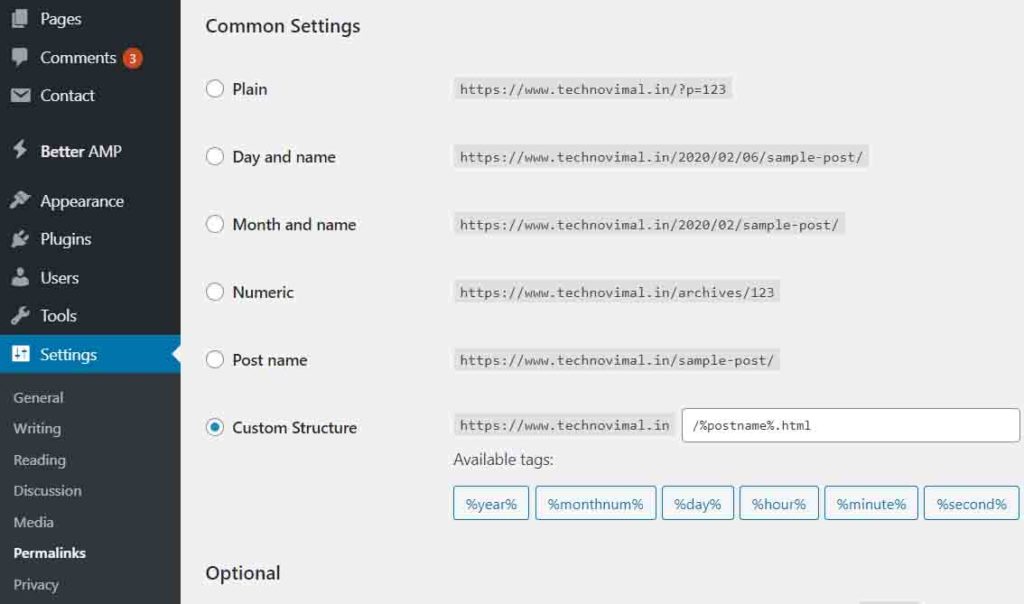Have you ever wondered what is the most SEO Friendly URL structure for SEO in WordPress? We often ask this question to new users. Because in the past the default WordPress URL structure was not compatible with SEO. However this has now changed. In this article, we will explain the WordPress SEO friendly URL and how you can optimize your permanent WordPress link.
You may also want to see:
What is an SEO Friendly URL?
SEO friendly URLs are URLs that are designed to meet the needs of users and searchers. In particular, URLs optimized for SEO are concise and keyword-rich.
Example of a SEO friendly URL:
https://www.technovimal.in/how-to-start-a-blog.htmlSo what does a non-SEO compatible URL look like?
https://technovimal.in/?p=10467
By default, WordPress now uses URL post names, which is the most SEO-friendly URL structure.
So why do beginners still ask us for the best permanent link structure?
Because in the past, WordPress did not use beautiful URLs, also known as permanent links. The default value used to be the non-SEO compatible example we shared earlier.
This was changed to WordPress 4.2. If you installed WordPress recently, your site’s URLs are compatible with SEO.
You can easily verify your permalink settings in your WordPress administration area.
The Permalink Settings Page Explained
In WordPress, the link is called Permanent Link (abbreviation for permanent link). You are using the term cross-linking structure and URL structure to exchange.
You must first go to the Permanent Links Settings page in your WordPress administration area.
Simply click on the Settings link on the Administrator menu and then click on Permanent Links. This will take you to a page that looks like this:

As you can see, several options are available.
Field:
https://technovimal.in/?p=123
Day and name:
https://technovimal.in/2020/02/05/sample-post/
Month and name:
https://technovimal.in/ 2020/02/sample-post/
Numerical:
https://technovimal.in/archives/123
Job Title:
https://www.wpbeginner.com/sample-post/
Custom Structure:
Choose your own URL structure with available tags.
Let’s explain these options a bit and how useful they are for users and SEO.
The first option of a simple name used to be the default WordPress URL structure. This is not an SEO friendly option.
The day and name option are somewhat SEO friendly because it has a publication name. However with the date the URL becomes too long. But most importantly after some time, its content seems obsolete, even if you update it regularly. Similarly the month and name options also risk being dated.
However, if it is a news publication you want your URL to have dates to show the news and improve the user experience.
In our opinion, those two structures are only good for news sites. Business sites that always hope to create green content should avoid it.
The publication name option is the most SEO friendly because it is short and beautiful.
If you are running a large publication you can use a custom structure that can also be compatible with SEO.
In TechnoVimal, we use a custom permanent link structure that appends the category name with the name of the post in the URL. Because our site is large and has thousands of articles we like it very much. You will see that large posts follow a similar URL structure.
To use a custom URL structure, you must add special tags to the custom structure box. For example, we use:
/%Category%/%Postname% /
Notice how each label is wrapped between percent signs. Also, inspect the slashes before and after the label.
Custom URL Structure with Available Tags
For the best results, we recommend using the options mentioned above. You can copy the URL structure we use in WPBeginner or choose a publication name as your URL structure.
However there are many other combinations that you can create using tags. Here is a list of tags that you can use to create your own custom URL structure:
% Second% – second of the minute, for example 33
% Minutes% – minutes of hours, for example 43
% Hour% – the time of day, for example 15
% Day% – the day of the month, for example 28
% Month% – the month of the year, for example 05
% Year% – year of publication, four digits, for example 2016.
% Postname% – a disinfected version of the publication title (slug field in the publication panel/publication page). For example, if the title of your publication is This is a Great Post! This will become a great post on this URL.
% post_id%: the unique ID number of the post, for example, 423
% Category%: an accepted version of the category name (category new / slug area in the category editing panel). Nested sub-categories appear as nested directories in the URI.
% Author%: an abbreviated version of the author’s name.
After choosing your permanent link structure be sure to click on the Save Change button.
As soon as you press the Save Changes button, WordPress will automatically update your site’s .htaccess file and your site will immediately start using the new URL structure.
Warning:
If your site has been running for more than 6 months, do not change your permanent link structure.
You may also want to see:
- Top 10 Best Free Web Hosting Sites with Complete Features
- How to Auto Reduce Server Response Time
- How To Start A Blog on WordPress?
Best Hosting Deals
- BlueHost Hosting Discount
- A2 Hosting Discount
- DreamHost Hosting Discount
- GeneratePress Theme Discount
- Mangools Toolkit Discount
If you liked this article, share it on the social networking site. You can also find us on Twitter, Facebook, and Instagram.


